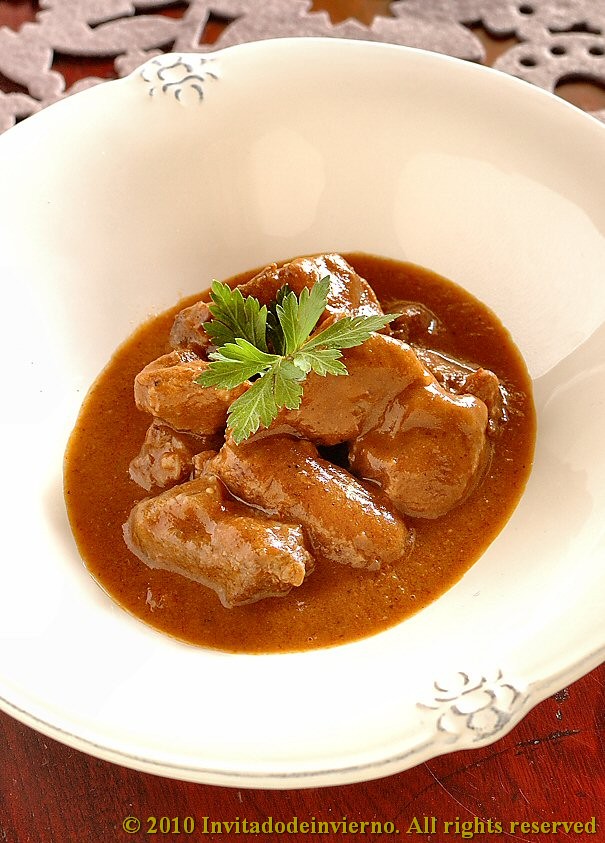Sephardic veal stew
>> Wednesday, October 13, 2010

This dish has been a classic in my family for some time already. It comes from one of my favorite cookbooks, in my collection for over 10 years, The Sephardic Kitchen, by Rabbi Robert Steinberg. It's one of those cookbooks that reads like a novel, and brings us closer to the kitchen of a culture that keeps many ties with Spain. The writing is very entertaining and the recipes are mingled with Sephardic folktales. It contains lots of very healthy and tasty dishes, many of those I still have to attempt... This hearty stew is one of those cases where the result is more than just the sum of its parts. A paradigmatic representation of this is a good torrija (Spanish style French toast), which makes you doubt that its creamy interior can consist only of bread soaked in milk. The succulent sauce of this stew is a perfect combination of ingredients, without any dominating over the others, and in which they all combine to create "something else" beyond the mere mixture of red wine, vegetables, honey and spices. You see, this amazing sauce inspires me and brings out the poet in me... Mmm, yum. Olé to this sauce...
And now to some historical background (an excerpt from this site), because in Spain most people know what Sephardim are, but I doubt the same holds outside Spain:Sepharad is the Hebrew word for the Iberian peninsula that includes Spain and Portugal. (...) Jews lived in Spain long before the Visigoth (Germanic) tribes invaded in 412, however after the Moorish invasion of Spain in 700, there was a large influx of Jews immigrating to Spain. In the tenth and eleventh centuries, Spanish Judaism flourished under Muslim rule, producing poets, scholars, and courtiers - what is known as "the golden age of Jewry." By the mid-thirteenth century, however, the Christians controlled all of the Peninsula except for a small area from Granada to the Mediterranean. In March, 1492, King Ferdinand and Queen Isabella decreed the expulsion of the Jews from Spain. Many Jews converted or left while others went to Portugal, where Judaism could still be practiced freely. But Portugal expelled its Jews in 1497, and the tiny kingdom of Navarre followed suit in 1498. Judaism could be practiced openly nowhere in the Peninsula. Driven from home, the Sephardim established their own congregations in such places as Morocco, Italy, Egypt, the Ottoman Empire, the Land of Israel, and elsewhere.
Mr. Steinberg tells us about this sopado, original name of this dish in ladino, the Judeo-Spanish language: It is a sweet and spicy veal stew, a typical Sephardic dish that was popular throughout the Jewish Mediterranean. The seasoning varies from one community to another. The recipe that follows is that used in Thessaloniki, Macedonia and northern Greece. Sopado reminds of Hungarian goulash, which only differs in the amount of onion and paprika employed.
Claudia Roden, in The book of Jewish food, tells us about Sephardic cooking: What we call Sephardi cooking today is the cooking of Mediterranean and Oriental Jews. There are four broad styles. Judeo-Spanish, which is Turkish and Balkan, is the cooking of the Jews of Iberian ancestry who went on to live in the Ottoman heartlands. North African or Maghrebi Jewish cuisine includes Moroccan, Tunisian, Algerian and Libyan. Then there is Judeo-Arab cooking, which is at its best in Syria and Lebanon, and the Jewish cooking of Iraq and Iran. (...) Sephardi cooking is sensual, aromatic and colourful. It makes use of anything that gives flavour - seeds, bits of bark, resins, pods, petals, pistils and flower waters. The Sephardim had a sunny, hedonistic nature (...) good eating has always been part of their traditional Jewish life. Their cooking is of a kind that lifts the spirits. The warm and sunny world they lived in had something to do with this, as had their way of life and historical experience.

Sephardic veal stew
It's an easy dish to prepare:
Like most stews, this stew is more tasty the next day, when all the flavors have developed and permeated the meat. For that, and because it is delicious, it is a dish that I cook often whenever I have guests, because I can prepare it the day before. Accompanied by a good rice or baked potatoes with herbs it makes a real fiesta dish.
Like a Sephardim would say: Berajá i salú...
















16 comentarios:
Very informative post and beautiful stew! This looks perfect for the fall weather!
Love the little history lessons thrown in for good measure. I love to learn the beginnings of my food.
woow,it look nice, tx for nice story as well..
Gorgeous photos, as usual, and thank you for the history. It's so great to have the context of what we're eating!
Looks delicious, I love the touch of allspice. Great Stew!
Have a great afternoon.
This sounds so delicious!
Unbelievably gorgeous.
Absolutely stunning!
I love it!
Miriam - Your site looks fantastic! I enjoyed your inspiration from the sauce and how poetically beautiful you've described it. The ingredients lists some spicy and rich flavors and this stew is pure comfort food for the soul - just wonderful.
As always, your images are stunning!
Lovely post on the background of Sephardic cooking and a great looking stew - I love the flavour combo of spices, honey and wine. Bet it tastes fantastic.
Great information and I love the end result stew!
A lovely read...your stew looks beautiful, and the photos are wonderful as always :)
I love the layered flavors and ethnic history that this dish represents - the honey and spices are so evocative of both North Africa and the Middle Ages when spices and honey seemed to be shoehorned into almost everything, I am transported back 500 years to Toledo's Juderia Vieja! Fabulous dish!
I don't know what I would do first: eating this incredible stew, admiring your photos, or swallow the water in my mouth at the thought of torrijas....!
Excellent!!!
Jenn: thanks!
Val: me too!
Yesim: thanks!
Belinda: thank you!
Mari: I love allspice too, it's a delicious aroma to add.
Heather: thanks!
Emily: just try it! ;)
Cristina: thank you!
Marisa: try it and you won't regret it... ;)
Simone: thank you!
MoS: thanks!
Jonny: wow... you're so right, one of the golden ages of mankind... in Toledo.
Cristina: gracias! Muaks.
Well I feel like I have found a home away from home! I love everything about this stew and will definitely try it. I am also curious about this book! I love Claudia Roden's book and cook from it often, especially at the holidays. And I have learned so much about Sephardic foods and traditions (being Ashkenaz myself) from her book as well.
I haven't visited your blog in some time and I must say your pictures are beautiful. The cava jelly looks amazing as does this stew (and that's one of the harder things to photograph).
Post a Comment